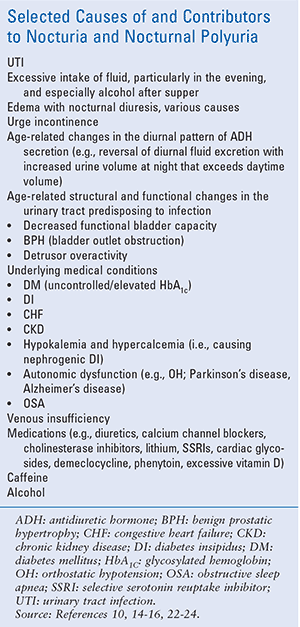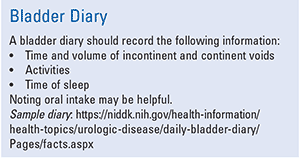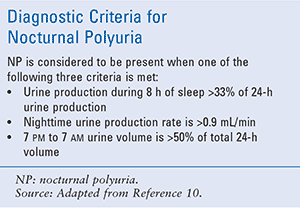US Pharm. 2017;42(8):Epub
Waking at night to pass urine, or nocturia, is a symptom that can be caused by a wide variety of conditions, such as congestive heart failure (CHF), poorly controlled diabetes mellitus (DM), medications, or diseases of the bladder or prostate. Nocturia is the most frequent cause of disturbed sleep in older adults; however, it is often overlooked as a cause of sleep problems in this population.1 This common condition in individuals aged more than 60 years has the potential to interrupt sleep to the extent that older adults suffer significant manifestations of sleep disruption, including daytime somnolence and cognitive impairment. Adversely affecting quality of life, nocturia is associated with social isolation, depression, and increased risk of morbidity and mortality, often secondary to falling; the elderly, due to frailty, are particularly vulnerable.2-4 It has been estimated that nocturia-related falls in the elderly (aged >65 years) cost the United States economy $1.5 billion per year.5
One of the most bothersome lower urinary tract symptoms in older adults, nocturia is defined as clinically significant if it involves the disturbance of sleep two or more times (i.e., >2 voids) at night, as this is when bother is perceived.1,6,7 One recent study noted that the prevalence of nocturia was estimated at 28.4%, 17.6%, and 8.9% for >1, >2, and >3 voiding episodes each night, respectively.8 When nocturia was defined as two or more voiding episodes at night, the prevalence decreased significantly.8
Nocturnal polyuria (NP) is a syndrome involving the production of an abnormally large volume of urine during sleep.8 While NP is commonly implicated in the etiology of nocturia, it is often unrecognized, even though its prevalence increases with age and has been reported to be as high as 77% and 93% in elderly women and men, respectively.9 Based on estimates, it is suggested that NP affects approximately 90% of individuals >80 years of age.10
In light of significant consequences, it has been suggested that healthcare providers seek out and address nocturia in older adults.2 Pharmacists can contribute to this call to action by identifying medications that cause or exacerbate urinary incontinence (UI), nocturia, and NP (TABLE 1) and offering problem-solving interventions and plans for improved outcomes. The challenge in this regard is assisting patients to achieve an acceptable degree of functionality, comfort, and safety.

Nocturnal Polyuria: Implicated in Nocturia
The definition of NP adopted by the International Continence Society is a nighttime volume of >20% of the daily total in younger patients (aged <65 years) and >33% of the daily total in the elderly (aged >65 years).11 While NP is considered to be present if one of three criteria is met (TABLE 2), the American Geriatrics Society supports the definition of the accumulation of one-third of 24-hour urine output between bedtime and waking, assessed via bladder diary (see resource) with measured voided volumes.12 Hofmeester and colleagues note that refinement of current definitions based on robust research is required.13 The researchers argue that based on pathophysiological reasoning, it may be more appropriate to define NP based on nocturnal urine production or nocturnal voided volumes rather than on a diurnal urine-production pattern.13
Overall, while the pathogenesis of NP is not completely understood, it is multifactorial in nature (TABLE 1). In some patients, NP is caused by factors that increase urine production, and by other factors that decrease the bladder’s ability to hold urine.2 For example, drinking large amounts of any fluid during evening hours—especially alcohol after supper—can contribute to NP due to age-related changes in renal function that compromise water- and sodium-conserving mechanisms.1 A dysfunction in the diurnal pattern of antidiuretic hormone (arginine vasopressin [AVP]) secretion occurs in some elderly patients such that a reversal of diurnal fluid excretion results; urine volume at night increases and exceeds daytime volume. Overproduction of AVP may be caused by disorders such as pneumonia and stroke.14 Neurologic disorders, such as Alzheimer’s disease and Parkinson’s disease, are also associated with changes in AVP secretion, as well as with natriuretic peptides.15
Overproduction of AVP may also be caused by drugs such as selective serotonin reuptake inhibitors (SSRIs), commonly prescribed in older adults.14 Furthermore, SSRIs have been associated with sodium deficiency, or hyponatremia, especially in elderly patients.16 Hyponatremia is primarily a result of excessive water retention caused by a combination of excessive intake and inappropriate antidiuresis, with neither edema nor signs of hypovolemia.17 Noteworthy, particularly for the elderly, is that even in cases of moderate hyponatremia that are considered asymptomatic, there is a very high risk of falls due to gait and attention disorders, as well as rhabdomyolysis, which increases the fracture risk.18
With regard to edema, conditions such as CHF, nephrotic syndrome, autonomic neuropathy, and venous insufficiency lead to interstitial edema formation during the day. NP results as the accumulated interstitial fluid mobilizes while the patient is recumbent.15
Diagnosis And Treatment of Nocturia and NP
Voiding diaries are essential for diagnosis (see Resource) of nocturia and NP. Of note, in nursing home residents and individuals with cognitive impairment, it is best to observe toileting patterns and UI episodes over several days rather than use bladder diaries.12 It is important to bear in mind that the first priority in treating nocturia and NP is to identify and treat concomitant conditions that may be contributing to it, such as DM, diabetes insipidus, urinary tract infection, hypercalcemia, and hypokalemia (TABLE 1). Any medications the patient may be taking that cause or exacerbate UI (e.g., nonsteroidal anti-inflammatory agents and thiazolidinediones causing edema and nocturnal diuresis; cholinesterase inhibitors causing increased uninhibited contractions and urgency) should be identified.12

Management of nocturia and NP is frequently nonsurgical.15 Nonpharmacologic measures may help, but are not effective as the sole therapy.2 In stasis edema, where edema accumulates through the day, use of compression stockings and elevation of legs should be considered.10,12 Although reducing fluid intake for 6 hours before recumbency is usually not successful, a decrease in fluid intake, and the avoidance of diuretics and caffeine before bedtime, is recommended. Phototherapy, thought to reset the body’s normal circadian rhythm, can be tried.15 In women with UI, pelvic floor (e.g., Kegel) exercises and scheduled voiding during the day are recommended.10,15 If sleep apnea is suspected, referral to a pulmonologist for consideration of continuous positive airway pressure is recommended.19
Pharmacologic Options for Nocturia: Focus on NP
In patients with heart failure and complaints of nocturia and NP, it is important to rule out heart failure exacerbation and treat if necessary.12 For those in whom benign prostatic hypertrophy is an issue, alpha-blockers and 5-alpha reductase inhibitors may be considered.2,10 In women with detrusor overactivity and urge incontinence, medications such as oxybutynin, solifenacin, and fesoterodine may be used.10,12 Caution should be taken, however, with the use of anticholinergic agents in light of their associated increased risk of falls and other troublesome class adverse effects (dry mouth, blurred vision, dry eyes, delirium/confusion/dementia, constipation) in the elderly.10,12,20 Topical estrogen creams may also be useful in some women.15
For the treatment of NP due to autonomic dysfunction (e.g., orthostatic hypotension, Parkinson’s disease), desmopressin 0.1 to 0.2 mg by mouth at bedtime, with monitoring for hyponatremia at initiation of treatment, is an option.2,12 This recommendation is contraindicated in patients with liver, kidney, or heart failure.12 Hyponatremia is a concern with the use of desmopressin, particularly in the elderly, in light of the risk for seizures, coma, and death; therefore, alternatives (discussed in this section) including addressing an underlying cause of nocturia and NP should be considered.2
Diuretics may be administered 6 to 8 hours prior to bedtime in an attempt to decrease overall volume status; for reversal of diurnal fluid excretion, a trial of a short-acting potent diuretic after supper (e.g., bumetanide 0.5-1.5 mg) should induce a brisk diuresis; if there is no response, a trial of desmopressin should be considered, as noted above.10,12
Conclusion
Nocturia and one of its potential etiologies, NP, can be attributed to a wide variety of systemic medical conditions, medications, or diseases of the bladder or prostate. Cornu and colleagues indicate that while our knowledge about nocturia (i.e., etiology and management) has substantially improved in recent years, there remains limited evidence regarding the management of nocturia; the researchers note that contributory factors include the following: 1) complexity of associated conditions, 2) underuse of objective evaluation tools, and 3) lack of specific focus on nocturia in clinical trials.21 Pharmacists need to do their part in helping identify patients with nocturia and NP, refer them for evaluation, and formulate pharmacotherapy plans that address medication-related contributors and conditions that should be managed optimally to minimize the potential for serious nocturia-associated consequences.
References
1. Osman NI, Chapple CR. Focus on nocturia in the elderly. Aging Health. 2013;9(4):389-402. www.medscape.com/viewarticle/809746. Accessed July 9, 2017.
2. Varilla V, Samala RV, Galindo D, et al. Nocturia in the elderly: a wake-up call. Cleve Clin J Med. 2011;78:757-764.
3. Vaughan CP, Brown CJ, Goode PS, et al. The association of nocturia with incident falls in an elderly community-dwelling cohort. Int J Clin Pract. 2010;64(5):577-583.
4. Nakagawa H, Niu K, Hozawa A, et al. Impact of nocturia on bone fracture and mortality in older individuals: a Japanese longitudinal cohort study. J Urol. 2010;184(4):1413-1418.
5. Holm-Larsen TWJ, Langkilde LK. Economic burden of nocturia in the US adult population. J Urol. 2010;183(Suppl):e1.
6. Ohayon MM. Nocturnal awakenings and comorbid disorders in the American general population. J Psychiatr Res. 2008;43(1):48-54.
7. Middelkoop HA, Smilde-van den Doel DA, Neven AK, et al. Subjective sleep characteristics of 1,485 males and females aged 50-93: effects of sex and age, and factors related to self-evaluated quality of sleep. J Gerontol Series A Biol Sci Med Sci 1996;51(3):M108-M115.
8. Zumrutbas AE, Bozkurt AI, Alkis O, et al. The prevalence of nocturia and nocturnal polyuria: can new cutoff values be suggested according to age and sex? Int Neurourol J. 2016;20(4):304-310.
9. Bosch JL, Weiss JP. The prevalence and causes of nocturia. J Urol. 2010;184(2):440-446.
10. Wong MK, Campbell KH. Fluid & electrolye abnormalities. In: Williams BA, Chang A, Ahalt C, et al., eds. Current Diagnosis & Treatment: Geriatrics. 2nd ed. New York, NY: McGraw Hill Education; 2014:261-268.
11. van Kerrebroeck P, Abrams P, Chaikin D et al. The standardisation of terminology in nocturia: report from the Standardisation Sub-committee of the International Continence Society. Neurourol Urodynam. 2002;21(2):179-183.
12. Reuben DB, Herr KA, Pacala JT, et al. Geriatrics at Your Fingertips: 2016. 18th ed. New York, NY: The American Geriatrics Society; 2016:146-156.
13. Hofmeester I, Kollen BJ, Steffens MG, et al. Impact of the International Continence Society (ICS) report on the standardisation of terminology in nocturia on the quality of reports on nocturia and nocturnal polyuria: a systematic review. BJU Int. 2015;115(4):520-536.
14. Beers MH, Jones TV, Berkwits M, et al. The Merck Manual of Health & Aging. Whitehouse Station, NJ: Merck Research Laboratories; 2004:216,374.
15. Kujubu DA. Nocturia in elderly persons and nocturnal polyuria. In: Geriatric Nephrology Curriculum. Washington, DC: American Society of Nephrology; 2009:1-4.
16. Rey JA. Antidepressants. In: Whalen K, ed. Pharmacology. 6th ed. Philadelphia, PA: Wolters Kluwer; 2015:137.
17. Robertson GL. Regulation of arginine vasopressin in the syndrome of inappropriate antidiuresis. Am J Med. 2006;119(7 suppl 1):S36-S42.
18. Vantyghem MC, Balavoine AS, Wémeau JL, et al. Hyponatremia and antidiuresis syndrome. Ann Endocrinol (Paris). 2011;72(6):500-512.
19. ClevelandClinic.org. Nocturia. 2017. https://my.clevelandclinic.org/health/articles/nocturia. Accessed July 21, 2017.
20. Fritsch MA, Shelton PS. Geriatric polypharmacy: pharmacist as key facilitator in assessing for falls risk. Clin Geriatr Med. 2017;33(2):205-223.
21. Cornu JN, Abrams P, Chapple CR, et al. A contemporary assessment of nocturia: definition, epidemiology, pathophysiology, and management—a systematic review and meta-analysis. Eur Urol. 2012;62(5):877-890.
22. Melin K. Antihypertensives. In: Whalen K, ed. Pharmacology. 6th ed. Philadelphia, PA: Wolters Kluwer. 2015:235.
23. Whalen K. Drugs for diabetes. In: Whalen K, ed. Pharmacology. 6th ed. Philadelphia, PA: Wolters Kluwer; 2015:344.
24. Semla TP, Beizer JL, Higbee MD. Geriatric Dosage Handbook. 20th ed. Hudson, OH: Lexicomp; 2015:434.
To comment on this article, contact rdavidson@uspharmacist.com.







